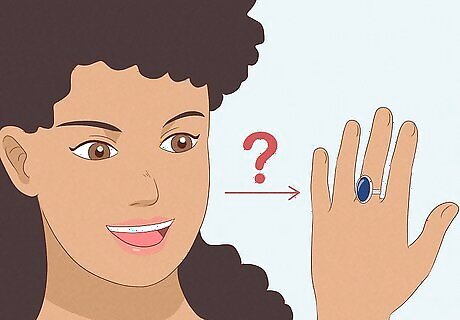
views
- Mood rings work because of the thermotropic liquid crystals inside of them. These crystals help the ring change color based on body temperature.
- Your mood ring may not accurately predict your mood all of the time because a variety of things can affect your body temperature besides your mood, like the environment and your activity level.
- Every mood ring manufacturer has a different guide for their ring’s color meanings, but dark blue usually means happy or relaxed and orange means tense or excited.
How does a mood ring change color?

Mood rings change color thanks to thermotropic liquid crystals. These liquid crystals turn different colors in different temperatures. So, when you put on a mood ring, the crystals inside the band or gem react to your skin’s temperature, showing a unique and vibrant color. The base of your ring conducts heat, transferring your body’s temperature to the liquid crystals inside. The crystals twist and move in response, and as their wavelengths change with the heat, their color changes. When your body temperature is stable, the crystals stay in a neutral state and project a blue or green color. As your temperature rises, the crystals compress into shorter wavelengths and appear purple in color. Thermotropic crystals are also used in watches, calculators, and computer screens to display images.
Can a mood ring really tell your mood?

Mood rings offer an educated guess, but can't accurately read emotions. Body temp changes are associated with your emotions. For example, happier emotions are associated with temperature rises, whereas sad feelings sometimes cause your body temp to drop. Mood rings can accurately read temperature (thanks to their thermotropic liquid crystals), so their readings can offer some insight. However, temperature alone can't predict your emotions. Other factors alter body temp besides your feelings, and at the end of the day, only you know exactly how you're feeling. Your body temperature can also be affected by the environment and your activity levels. Are you someplace cold? Have you been exercising? Mood rings can’t predict complex emotions, complicated feelings, or subtle mood shifts, as one simple color can’t describe everything you’re experiencing. Even if a mood ring isn’t always right, they’re still super fun to use and wear!
Mood Ring Color Meanings

Your mood ring will change color based on your body’s temperature. If you’re feeling a certain way, you may notice the color swirling and changing, especially when you get hot or cold. Now, every mood ring and manufacturer is different, so it’s always best to check your ring’s box or packaging for a color meaning guide, but here are the most common mood ring colors and their meanings: Dark blue: Relaxed, happy Light blue: Calm, peaceful Green: Active, average Purple: Love, moody Pink: Uncertain, mixed emotions Orange: Tense, excited Brown: Nervous, anxious Black: Overwhelmed, angry




















Comments
0 comment